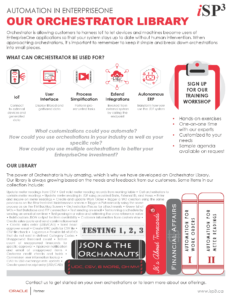Orchestrator, a JD Edwards EnterpriseOne tool already available at your fingertips, allows you to build microservices. It’s designed to be used by analysts, developers, and super users who have a good understanding of the EnterpriseOne application.
iSP3 ORCHESTRATOR LIBRARY
Our team has been working with our customers to develop an Orchestrator Library. Coupled with our development services to customize them for you, we’ve been able to ensure they are executed correctly resulting in planned and strategic Orchestrations.
Does your company do Meter Readings? Now we have a series of Orchestrations in our library that will allow you to process your meter readings by validating CSV input, updating readings in JDE, and logging errors for your reporting.
We can also help you to automate your exchange rate updates to multiple currencies with an easily managed Orchestration. From a source currency to multiple others, updated daily.
To learn more about our complete Orchestrator Library click the image on the right or contact us.




